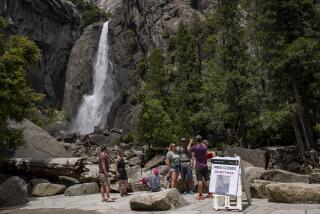Nearly roadkill
- Share via
Zion National Park, Utah — The Virgin River is running cold and green through thick cottonwood stands. Meadows lush with native grasses lap up against shockingly red sandstone. At lower elevations, cactuses dot the rocky slopes; higher up, hanging gardens cling impossibly to sheer cliffs that soar 3,000 feet above the canyon floor.
It’s a magnificent scene here now. But five years ago, the floor of Zion Canyon, in the southwest corner of Utah, looked more like the deep and narrow Yosemite Valley often does today: gridlocked.
“Too many cars,” said Zion National Park ranger Ron Terry of the late ‘90s. On a summer day, he said, 4,000 automobiles would enter the canyon -- 5,000 on a busy weekend -- in search of one of only 400 parking spaces at trail heads.
The congestion forced visitors to park illegally on road shoulders, trampling bushes and cactuses. The noise, amplified by the cliffs, was intolerable. “Slamming doors, car alarms, horns honking, conflicts between drivers vying for parking spaces,” Terry recalled.
Wildlife fled the canyon. Something had to be done.
Zion officials considered building more parking spaces or restricting canyon access. Ultimately, though, a third option emerged: a mandatory shuttle system that became the first of its kind in the nation. Kick out the vehicles, the thinking went, and conditions will improve.
So in spring 2000, Zion National Park banned cars from its upper canyon. At the same time, it launched a free shuttle system, maintained by $2.5 million a year in park entrance fees. A fleet of 30 buses and 21 trailers travels up canyon as far as the Temple of Sinawava -- where the walls converge, marking the beginning of the Narrows -- and down canyon through Springdale, a gateway community on the Virgin River where hikers now leave their cars.
Terry saw an immediate effect on the canyon. And these days, five years after the shuttle launch, wild turkeys again roam the canyon floor. Mule deer graze beside river meadows. The elusive collared lizard -- known for running on its hind legs -- lounges on warm rocks. In Hidden Canyon, its mouth gaping 1,000 feet above the Virgin River, the echoing wing sounds of raven and peregrine falcon cut the early morning stillness. “The animals have come back,” Terry said. “The natural quiet of the canyon has returned.”
In Springdale, shuttles did not drive away visitors as feared. About 2.5 million come each year. Hotel owners credit the shuttle with doubling the average visitor stay to two days. Two new hotels have been built to meet demand.
Perhaps the only initial drawback, said locals, was that virtually overnight the lunchtime crowd disappeared as hikers spent more time in the canyon and less in town waiting for traffic to ease.
“The shuttle almost killed my deli over there,” said Alma Young, who also owns a hotel, market and self-service laundry in town. Restaurateurs ultimately adjusted their hours to stay open later. During the day, some eateries close altogether, creating what locals have dubbed the “Springdale siesta.”
Meanwhile, the larger and more popular Yosemite National Park is addressing congestion with an optional shuttle system that absorbs a fraction of the nearly 7,000 cars jamming the valley on a busy summer day. “We have problems with cars parking illegally,” says ranger Deb Schweizer. “We have to put up barriers to keep visitors from parking in the meadows or other sensitive and protected areas.”
Simple as it seems, Zion’s mandatory-shuttle model is a tough fit for Yosemite, Schweizer said, because it would require launch points at the three major entrances. But “we are watching Zion’s progress,” she says. “We’re interested to see how their system works, to take a close look. That way, we can create a system that’s going to work for Yosemite.”
Schweizer said that within 15 to 20 years, the park hopes to install a system that would carry day-tripping visitors into the valley on crowded weekends and holidays.
Until that happens, the formerly frustrated drivers of Zion get to gloat alone.
“In the past, we’d drive into the canyon and have trouble finding a parking spot,” says Rex Willard, a Zion visitor from the Salt Lake City area, while hiking the trail to Emerald Pools. “We’d have to walk a mile and a half just to get to a trail head.”
“And by then,” says his grandson, 12-year-old Troy Jacobs, “it’d be time to go home.”
More to Read
Sign up for The Wild
We’ll help you find the best places to hike, bike and run, as well as the perfect silent spots for meditation and yoga.
You may occasionally receive promotional content from the Los Angeles Times.






